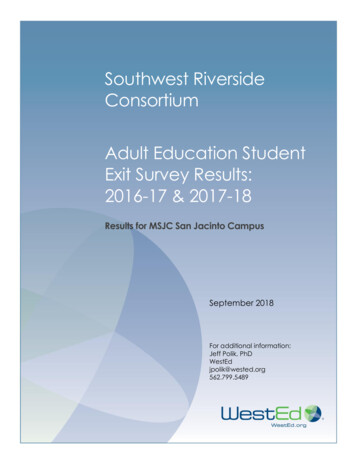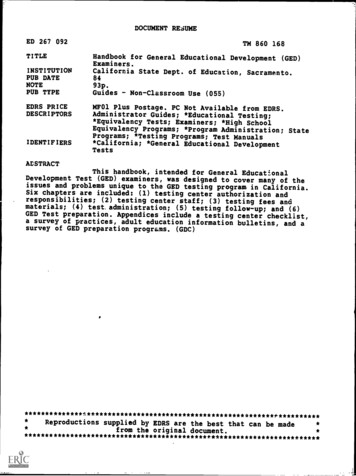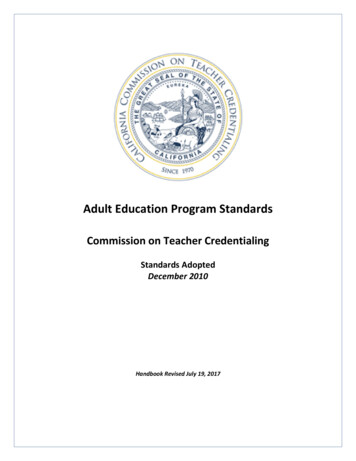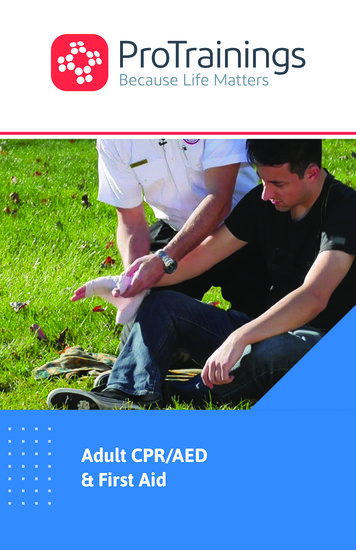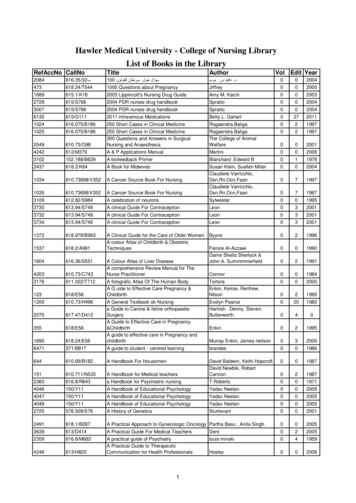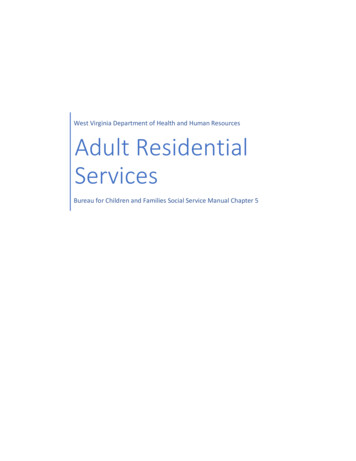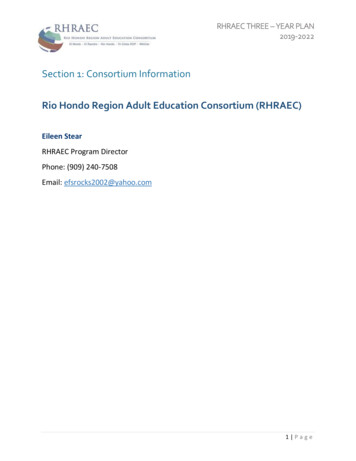
Transcription
Comprehensive Adult Student Assessment SystemsCASAS GOALS Overview,CCR Alignment and Test ReportsAugust 2019Linda Taylor, CASASltaylor@casas.org
Agenda Reading GOALS Overview The CCR Standards aligned to the Reading GOALSTest Blueprint and Reading GOALS test items Understanding and using Student Competency,CASAS Reading Standard, and new CCRS reportsfor Reading GOALSwww.casas.org/si2
Integrated System Approach CASAS Competencies Basic Skills Content Standards Reading, Listening & Math NRS-approved Assessments Reading, Listening & Math Computer-delivered CASAS eTests (includesChromebooks and iPads) and Paper QuickSearch Online - Instructional Material Titles TOPSpro Enterprise software Automatically scores tests Produces student, class and agency level reportswww.casas.org/si3
How the Use CASASLocator orAppraisal tofind appropriatepretests andplace studentsin program.www.casas.org/siSystem Works Use CASASpretests toplace studentsinto NRSEducationalFunctioningLevels (EFLs)and identifyinstructionalneeds. Use pretestresults to guideteaching. Use CASAS posttests to measurelearning gains anddocument Use QuickSearchcompletion of NRSOnline to findEFLs.curriculumresources.4
CASAS NRS-approved Assessments for ABE NRS-approved through 2025 Reading GOALS (900 series) NRS-approved through 2022 Math GOALS (900 series)www.casas.org/si5
CASAS NRS-approved Assessments for ESLNRS-approved through February 2021(like all other NRS-approved ESL tests) Life and Work Reading (80 series) Beginning Literacy, Forms 27 and 28 and Reading for Language Arts (Forms 513/514) Life and Work Listening (980 series)www.casas.org/si6
Next Steps for GOALS Reading GOALS for ESLOCTAE has requested additional data Math GOALSOCTAE has requested additional data Listening GOALSIn developmentwww.casas.org/si7
Transitioning Students to GOALS Students transitioning from Life and Work Reading to the GOALSseries must take a pretest in the new GOALS series. Pre- and post-test results must always be in the same test series. Recommend giving the GOALS Locator (104R and 104M) The same CASAS testing procedures and reports apply for Readingand Math GOALS. Agencies may create their own testing sessions or contact CASASTech Support for assistance with adding new templates for GOALStest sessions (800-255-1036, ext. 2). Intake screening for new ABE students should be done only forwriting, and not for not oral skills -- before deciding aboutadministering a Locatorwww.casas.org/si8
GOALS Series Reports and Content Standards CASAS Content Standards reports and CASAS Competency reports aresimilar for the GOALS test series. Reading GOALS and Math GOALS reports are available now. CASAS Reading Standards, version 2 has been uploaded to the CASASwebsite. CASAS Math Standards are available on the CASAS website. They are both strongly aligned to the CCRS. In addition New CCRS reports will be available this summer for theReading and Math GOALS series.www.casas.org/si9
Math GOALS Serieswww.casas.org/si10
Math GOALS 4M900M913914917918Number ofTest Items102015 min.30 min.4060 min.3875 min.Timing Aligned to the CCR Standards for Adult Education and CASASCompetencies Formulae are provided so focus is on math concepts and skills, notmemorization.www.casas.org/si11
EFLs in Math GOALSMath SeriesNRS EFLLevelNRS EFLforMathematicsA/BC/DFormsForms1Beginning LiteracyEnter & Complete2Beginning BasicEnter & Complete3Low IntermediateEnter & Complete4Middle IntermediateEntry into Level 45High IntermediateEnter & Complete6Adult SecondaryEntry into Level 6www.casas.org/siEnter & Complete12
Old to New NRS Math EFLs and ScaleScore RangesNRSEFLOldABE/ASE EFLsLife Skills MathScale ScoreRangesNRSEFL200 & below1Beginning LiteracyNewABE/ASE EFLs forMathematicsMath GOALSScale ScoreRanges1Beginning Literacy2Beginning Basic201 - 2102Beginning Basic194 - 2033Low Intermediate211 - 2203Low Intermediate204 - 2144Middle Intermediate215 - 225226 - 2354High Intermediate221 - 2355High Intermediate5Low Adult Secondary236 - 2456Adult Secondary6High Adult Secondary246 & abovewww.casas.org/si193 & below236 & above13
Math SeriesThe Math GOALS Series was built to address: CASAS Competencies provides the context for assessing skills used in academic and employmentsettings, as well as everyday life skills Content Standards CASAS Math Standards CCR Standards for Adult Education Number SenseAlgebraGeometry and Geometric MeasurementData, Probability, Statistical MeasurementMathematical Practices NRS Educational Functioning Level (EFL) Descriptors for Mathwww.casas.org/si14
CASAS and CCR Math StandardsCASAS Math Content AreasM1: Number SenseM2: AlgebraM3: GeometryM4: MeasurementM5: Statistics, Data Analysis,ProbabilityCCR Standards*Number and RatioAlgebra and FunctionsGeometryData, Probability and StatisticalMeasurement* CCRS domains of Geometry and Statistics include content from CASAScategory M4: Measurementwww.casas.org/si15
CASAS Math BlueprintCASAS ContentDomainsM1: Number SenseCASASLevelA/B28%CASASLevelC/D15%Math SeriesCollege and Career Readiness Standards (CCRS) Covered byCASAS Math Goals SeriesAt the A/B level, use basic concepts of number system, place values, operations of addition,subtraction, multiplication and division, fractions, fraction equivalents, ratios and proportions.At the C/D level, use advanced number concepts such as comparing fractions, usingoperations with rational numbers and exponents.At the A/B level, understand and reason with properties of four operations, explain patternsin four operations, solve basic one-variable equations.M2: Algebra14%30%At the C/D level, generate equivalent equations and those with two or more variables,understand radicals, use lines and linear equations, use functions and functional expression,including inequalities, polynomials, quadratics, and exponential models.At the A/B level, identify and reason with shapes and their attributes in 2- and 3-dimensions,find area and volume.M3: Geometry10%11%At the C/D level, solve problems of angle, area, congruence, similarity, trigonometry, volumesof cone, pyramids and spheres.At the A/B level, measure with standard units, time intervals, liquid masses and volumes,area, unit conversions, angle measurements.M4: Measurement*30%28%At the C/D level, understand/apply Pythagorean theorem, use volume measurements forcomplex modeling.At the A/B level, understand categories, identify relevant data in tables, represent data ingraphs, understand variability, and describe distributions.M5: Statistics andProbability**18%16%At the C/D level, understand probability, sampling, draw inferences, summarize and interpretdata categorical and quantitative data, draw inferences, investigate associations in bivariatedata.* CCRS domains of Geometry and Statistics include content from CASAS category M4: Measurementwww.casas.org/si16
On-screen calculator in CASASMidtown Gym costs 40 per month to joinbut is having ahalf-price specialfor August.www.casas.org/si17
On-screen calculatorCalculator opensand can be movedto any position onthe screen.Includes only basicfunctions.www.casas.org/si18
Calculators in Math GOALSMath Series Students may use a calculator throughout the entire math test. CASAS eTests provides an on-screen calculator, but students may usephysical calculators (not graphing calculators) while testing on CASASeTests, if preferred. Programs that use paper-based tests should provide students with acalculator. Students may not use a personal calculator nor their cell phonecalculator. Examples of appropriate calculators are Texas Instruments TI-30XS,TI-108 and TI 503SV, Casio SL-300SV, and other approved calculatorsfor use on high school equivalency exams such as the GED, HiSET, andTASC assessments.www.casas.org/si19
Focus of CCR Math StandardsMath Series Deeper understanding of key mathematical foundations, concepts,procedural fluency Rigorous application of conceptual understanding, procedural skill,and application to real-world contexts students employ conceptsfrom several perspectives know more than “how to get theanswer”. In a nutshell, emphasis is now on: “seeing the bigger picture” knowing the meaning of answers (not just having numbers) applying concepts to solve problemswww.casas.org/si20
New Math GOALS FeaturesMath SeriesA range of item types is provided, including: Situational scenarios that reflect real-world applications Word problems (reading complexity and cognitive load areconsistent with level-specific expectations) Simple to advanced calculation Traditional academic contextswww.casas.org/si21
Sample Test ItemsReview and compare sample test items. Sample eTests and paper testformats are available at www.casas.org: Use sample test items to:o familiarize and give students practicewith CASAS itemso make future testing go more smoothlyo help reduce student test-taking anxietywww.casas.org/si22
NEW Sample Test Items in eTests format Go to the CASAS Portal to view Sample Test Itemsin the eTests format 3
ReadingSeries www.casas.org/si24
Reading GOALS 900R901902903904905906907908Number ofTest Items122815 min.30 min.3960 min.4075 min.4075 min.4075 min.Timing Reading GOALS Locator: 104R (12 questions) – fixed form (not CAT) Aligned to the CCR Standards for Adult Education and CASAS Competencies Measures rigorous academic skills in contexts relevant to lives of adultlearners
NRS EFLs and Reading GOALS Scale ScoreRangesNRSEFLABE/ASE LevelsReading GOALSScale Score RangesLife and WorkReading Scale ScoreRanges203 and below200 and below1Beginning ABE Literacy2Beginning Basic Education204 - 216201 - 2103Low Intermediate Basic Education217 - 227211 - 2204High Intermediate Basic Education228 - 238221 - 2355Low Adult Secondary Education239 - 248236 - 2456High Adult Secondary Education249 and above246 and abovewww.casas.org/si26
WIOA Title I/EFLs, CASAS scores, and GLEswww.casas.org/si27
New Test Series ContentCASAS new Reading GOALS Series Blueprint reflects: CASAS Competencies Content Standards CASAS Reading Standards CCR Standards for Adult Education in the areas of: Reading Reading Foundations Reading Task Areas Depth of Knowledge (DOK)www.casas.org/si28
Reading GOALS Item Types Multiple choice – All levels Comprehension (in existing Reading tests) Sentence completion New text and item features – Levels B, C, D Numbered lines in text passages Underlined words embedded in passage Level A only Photo prompts and distractors in beginning of the test Item Families – Multiple items related to one readingpassage makes efficient use of test timewww.casas.org/si16
In line 2, which word means the same as theunderlined word liberal in this announcement?A. generousB. radicalC. traditionalD. widespread
The Academic Word List (AWL) Developed by Averil Coxhead at the School of Linguistics and AppliedLanguage Studies at Victoria University of Wellington, New Zealand. The list contains 570 word families which were selected because theyappear with great frequency in a broad range of academic texts. The list does not include words that are in the most frequent 2000words of English (the General Service List), thus making it specific toacademic contexts. An alphabetized version is available online. CASAS used the AWL list for the GOALS Reading series.www.casas.org/si31
Depth of Knowledge (DOK)Describe levels of cognitive processing and higher-orderthinking required in the College and Career ReadinessStandards.Four DOK levels:1.2.3.4.Recall, Reproduction, RecitationApplication of Skill/ConceptStrategic ThinkingExtended Thinkingwww.casas.org/si32
Level D Reading Sample Test Item –Analyze claimThe writer distinguishes between leasing and buying by emphasizing the .A. affordability of leasing a carB. high cost of purchasing a carC. similarities of both optionsD. pros and cons of the optionswww.casas.org/si33
Level D Reading Sample Test Item –Infer/draw conclusionsWhich statement would make the best conclusion to this article?A.B.C.D.www.casas.org/siLeasing the newest model beats owning an older one.The decision depends on each person’s situation.It is obvious that leasing involves too many costs.Most experts see little difference between leasing and buying.34
CASAS test itemsmeasure basiclanguage andmath skills inrealistic, everydaylife and workplacecontexts.Test items address: contentstandards competencies task areasModule 4: Interpreting Test Results and ReportsContentStandardsCompetenciesTask Areas35
Content Standards, Competencies, andTask AreasBasic Skills ContentStandardAcademic skill measured(e.g., locate detail)CompetencyA measurable learning objectivein a functional life skills context(e.g., read an activity schedule)Task AreaFormat of the test item prompt(read a chart)www.casas.org/si36
Content StandardsAcademic skills in language andmathematics
College and Career Readiness (CCR) Standards*Key Goals: Ensure core college and career readinessrequirements for adult learners are representedbut also keep the overall content demandsmanageable Include standards that are:o relevant to preparing adult students for successin higher education and training programso most important for adult learners*College and Career Readiness (CCR) Standards for Adult Education –published by the U.S. Department of Education, Office of Career,Technical, and Adult Education (OCTAE) - April 2013.
Example of CCR Reading StandardCCR Anchor 4: Interpret words and phrases as they are used in a text,including determining technical, connotative, and figurative meanings, andanalyze how specific word choices shape meaning or tone.ABCDEAsk and answerquestions to helpdetermine orclarify themeaning ofwords andphrases in a text.Determine themeaning of generalacademic anddomain specificwords and phrasesin a text relevant toa topic or subjectarea.Determine themeaning of generalacademic anddomain specificwords and phrasesin a text relevant toa topic or subjectarea.Determine themeaning of wordsand phrases asthey are used in atext, includingfigurative,connotative, andtechnicalmeanings;analyze theimpact of specificword choice onmeaning andtone.Determine themeaning of wordsand phrases asthey are used in atext, includingfigurative,connotative, andtechnicalmeanings; analyzecumulative impactof specific wordchoices onmeaning and tone.Determine themeaning of wordsand phrases as theyare used in a text,including figurativelanguage such asmetaphors andsimiles.Module 4: Interpreting Test Results and Reports39
In line 2, which word means the same as theunderlined word liberal in this announcement?A. generousB. radicalC. traditionalD. widespreadCCR StandardR4.B, C: Interpret words and phrasesin a text
Alignment of CASAS Reading Standards andCollege and Career Readiness Standards (CCRS)CASAS Reading GOALS Content AreasVocabularyReading Comprehension SkillsLocate detailMain idea; Author’s purposeCCRSReadingAnchor*R4R1R2, R6Higher Order Reading SkillsLocate/compare details;Infer/draw conclusionsText structure and featuresAuthor’s point of viewAnalyze claim/argumentR1, R9R5R6R8*CCRS Reading Standards R7 and R10 are measured across content areas.CASASwww.casas.org/siImplementation Basics41
CASAS Reading Standards CategoriesRDG 1 - Foundational LiteracyRDG 2 - Language and VocabularyRDG 3 - Reading Comprehension Skills and StrategiesRDG 4 - Higher Order Reading Skills and StrategiesRDG 5 - Higher Order Reading Skills and Strategies –Literary Texts Only
NEWCASAS Reading Standards 2016, Second Edition Combined, reduced, re-named and re-organized the categories andstandards Number of categories reduced from 9 to 5 Number of standards reduced from 125 to 51 Added new standards from the CCR Standards for Adult Education inthe English Language Arts and Literacy areas of Reading, ReadingFoundations and Language. All CCRS Standards in these 3 areas are referenced at least once in therevised CASAS Reading Standards. To align assessment with instruction, the categories in the revisedCASAS Reading Standards will be the same as the categories forreporting test results for the new CASAS Reading series. Posted on www.casas.org – with dots for ABE/ASE and ESLwww.casas.org/si43
CASAS Reading Standards exampleRDG 2 Language and VocabularyABE/ASE NRS LevelESL NRS Level 1Content StandardCASASCS #Instructional LevelARDG 2Language and Vocabulary RDGInterpret the conventions of standard English including2.1punctuation (e.g., periods, appropriate placement of commas,quotation marks) and capitalization (e.g., at the beginning of asentence, proper nouns).[L2. A, B, C, D, E] RDGRead and interpret high-frequency words, phrases, and2.2abbreviations in everyday contexts (e.g., signs, ads, labels,forms).[L6. A, B] [R4. A]RDGInterpret accurately a range of general academic (e.g.,2.3indicate, procedure, evidence), technical (e.g., phlebotomist),and domain-specific words and phrases (e.g., endangeredspecies, peace treaty) in context, including collocations (e.g.,count on, happen to).[L6. B, C, D, E] [R4. B, C, D, E]1 2 3 4 5 62 3 4 5 6AA B B C D E
In line 2, which word means the same as the underlinedword liberal in this announcement?A. generousB. radicalC. traditionalModule4: Interpreting Test Results andD.widespreadReportsCASAS Reading StandardRDG 2.8 - Interpret multiple-meaningwords
CASAS Reading Standards – CCR AlignmentCS #RDG2.7RDG2.8Content StandardInstructional LevelABE/ASE NRS Level1 2 3 4 5 6ESL NRS Level 1 2 3 4 5 6CASASAAABBCDE Interpret nuances, connotative meaning ofwords, and figurative language (e.g., analogies, idioms, similes and metaphors) as used in the text.[L5. A, B, C] [R4. C, D, E]Interpret unknown and multiple-meaning words as used in the text, choosing from levelappropriate strategies (e.g., context clues).[L4. A, B, C, D, E] [R4. A, B, C, D, E]CCR Anchor R4: Interpret words and phrases as they are usedin a text, including determining technical, connotative, andfigurative meanings, and analyze how specific word choicesshape meaning or tone.www.casas.org/si46
Skill ReportsStudent Content Standard Performance provides detailed information on student testresults by test item CASAS content standardContent Standard Performance Summary a class-level report teachers use to target theareas of greatest need for the entire class.www.casas.org/si47
Content Standard Reportswww.casas.org/si48
Student PerformancePage 1 of 101/06/2019by Test & Content StandardSCSTC23:30:594908 – Rolling Hills Adult School (RHAS)Agency:Form:906R - Reading GOALS Level CSite: Class: 11 – RHAS: North CityStudent:Perez, Maria ID: 123456Course:61392 - Reading Skills 3Test Date: 01/06/2019Teacher:RS3BEERaw Score: 19Scale Score: 220CASASReadingStandards(2016)RDG2.3No. ofItems4Correct50 %RDG2.830%RDG3.11RDG3.12RDG3.14RDG4.32133250 %38 %100 %100 %RDG4.4743 %RDG4.610%RDG4.7250 %RDG4.8367 %www.casas.org/siContent Standard DescriptionInterpret accurately a range of general academic (e.g., indicate, procedure, evidence), technicale.g., phlebotomist), and domain-specific words and phrases (e.g., endangered species, peacetreaty) in context.Interpret unknown and multiple-meaning words as used in the text, choosing from levelappropriate strategies (e.g., sentence-level, paragraph or complete text context, known affix,root words).Identify the main idea of a simple text or the central ideas or themes of a complex text.Identify the key details and cite evidence from a text.Identify the author’s purpose including what the author wants to answer, explain or describe.Determine what a text says implicitly (e.g., make inferences, draw conclusions) and cite textualevidence.Analyze how and why individuals, events, and ideas develop and interact over the course of atext, including time, cause/ effect, sequence (e.g., following multi-step directions).Analyze how the author’s purpose, point of view, opinion, register, tone and voice, includingpolitical or cultural perspective, shape the content and style of a text for its intended audience.Distinguish own point of view, including personal experience, from the author’s point of view.Explain, delineate, analyze, and evaluate the truthfulness, validity, relevance, and sufficiency ofarguments, specific claims and supporting evidence in expository, academic or non-fiction text,including differentiating fact from opinion (e.g., advertising claims, news articles, case studies).Integrate and analyze how two or more texts address similar or conflicting themes or topics inorder to build knowledge, compare or contrast the approaches the author(s) takes, or identify49where the texts agree or disagree on matters of fact or interpretation.
ClassPerformance01/06/201923:34:49Page 13 of 32SCSSTC4by Test & Content Standard4908 – Rolling Hills Adult School (RHAS)Agency:Teacher: 521457 - Goldberg, CSite: Class: 11 – RHAS: North CityForm:906R - Reading GOALS Level CCourse:61392 - Reading Skills 3Total Students:13Total Tests: 13RS3BEECASASReadingStandardsNo. of(2016)ItemsCorrectContent Standard DescriptionRDG2.3456 %RDG2.8351 %RDG3.11RDG3.12RDG3.14RDG4.32133265 %57 %59 %58 %RDG4.4752 %RDG4.6123 %RDG4.7265 %RDG4.8367 %www.casas.org/siInterpret accurately a range of general academic (e.g., indicate, procedure, evidence), technicale.g., phlebotomist), and domain-specific words and phrases (e.g., endangered species, peacetreaty) in context, including collocations (e.g., count on, happen to).Interpret unknown and multiple-meaning words as used in the text, choosing from levelappropriate strategies (e.g., context clues).Identify the main idea of a simple text or the central ideas or themes of a complex text.Identify the key details and cite evidence from a text.Identify the author’s point or purpose including what the author wants to answer, explain or describe.Determine what texts says explicitly by comparing details from multiple sources or parts of a text.Determine what texts says implicitly (e.g., make inferences, draw conclusions) and cite textualevidence.Use text features (e.g., bold face print, symbols) to locate key details and interpret how thesefeatures influence meaning.Describe and analyze the overall structure and organization of a text (e.g., chronology, case andeffect, comparison and contrast, problem and solution.Analyze how the author’s point of view, purpose, opinion, register, tone, and voice, including50political or cultural perspective, shape the content and style of a text for its intended audience.
CompetencyThe functional life skills context inwhich the learning objective isbeing measured
CASAS Competency Categories0.1.2.3.4.5.6.7.8.Basic CommunicationConsumer EconomicsCommunity ResourcesHealthEmploymentGovernment and LawMathLearning and Thinking SkillsIndependent Living
CASAS Competencies – example4. Employment4.6 Communicate effectively in the workplace4.6.1 Follow, clarify, give, or provide feedback toinstructions; give and respond appropriately to criticism4.6.2 Interpret and write work-relatedcorrespondence, including notes, memos, letters,and e-mail4.6.3Interpret written workplace announcements andnotices (see also 4.4.3)4.6.4 Report progress on activities, status of assignedtasks, and problems and other situations affecting jobcompletion4.6.5 Select and analyze work-related information for agiven purpose and communicate it to others orally or inwriting
In line 2, which word means the same as the underlinedword liberal in this announcement?CASAS CompetencyA. generousB. radical4.2.4 Interpret employee handbooks,C. traditionalpersonnel policies, and job readReports
Skill ReportsCompetency Performance Summary a class-level report teachers use to target the areas ofgreatest need for the entire class. Student Competency Performance provides detailed information on student test results by test item competency task areawww.casas.org/si55
Student Competency Performancewww.casas.org/si56
Student Competency on1234567891011121314154908 – Rolling Hills Adult School (RHAS)11 – RHAS: North CityForm:61392 - Reading Skills 3Test Date:01/05/2019RS3BEE521457 - Goldberg, CRaw YesNowww.casas.org/siComp dent:906R - Reading GOALS Level CPerez, MariaID: 123456Scale Score: 220Competency DescriptionInterpret information about employee benefitsInterpret information about employee benefitsInterpret information about employee benefitsInterpret information about employee benefitsInterpret job-related signs, charts, diagrams, forms, etc.Interpret job-related signs, charts, diagrams, forms, etc.Interpret job-related signs, charts, diagrams, forms, etc.Interpret job-related signs, charts, diagrams, forms, etc.Interpret work-related correspondence, e.g. memos and e-mailInterpret work-related correspondence, e.g. memos and e-mailInterpret work-related correspondence, e.g. memos and e-mailInterpret work-related correspondence, e.g. memos and e-mailInterpret work-related correspondence, e.g. memos and e-mailInterpret product instructions, directions, labelsInterpret product instructions, directions, labels57
Class -- Competency Performance SummaryClass se:Position1234567891011121314151617181920Page 1 of 5SCPSTIC4by Test Item & Competency4908 – Rolling Hills Adult School (RHAS)11 – RHAS: North CityTeacher:61392 - Reading Skills 3Total Tests:Form:521457 - Goldberg, C906R - Reading GOALS Level C13Total Students:13RS3BEECorrect?61 %61 %69 %69 %69 %92 %46 %53 %46 %61 %61 %69 %61 %38 %76 %46 %61 %46 %76 %53 %www.casas.org/siComp 4.1Task22221111222223333222Competency DescriptionInterpret information about employee benefitsInterpret information about employee benefitsInterpret information about employee benefitsInterpret information about employee benefitsInterpret job-related signs, charts, diagrams, forms, etc.Interpret job-related signs, charts, diagrams, forms, etc.Interpret job-related signs, charts, diagrams, forms, etc.Interpret job-related signs, charts, diagrams, forms, etc.Interpret work-related correspondence, e.g. memos and e-mailInterpret work-related correspondence, e.g. memos and e-mailInterpret work-related correspondence, e.g. memos and e-mailInterpret work-related correspondence, e.g. memos and e-mailInterpret work-related correspondence, e.g. memos and e-mailInterpret product instructions, directions, labelsInterpret product instructions, directions, labelsInterpret product instructions, directions, labelsInterpret product instructions, directions, labelsIdentify behavior, attitudes for job retention, advancementIdentify behavior, attitudes for job retention, advancementIdentify behavior, attitudes for job retention, advancement58
Student Performanceby Competency :Page 1 of 1SCPCCby Competency Category4908 – Rolling Hills Adult School (RHAS) Teacher: 521457 - Goldberg, CForm Level: C11 – RHAS: North CityStudent:61392 - Reading Skills 3Perez, MariaID: 123456RS3BEEComp No. Correct1.725 %4.225 %5.433 %4.446 %3.650 %5.675 %4.680 %www.casas.org/siStudentPerformanceTotal Tests:1Competency DescriptionUnderstand procedures for care of personal possessionsUnderstand wages, benefits, and employee organizationUnderstand information about taxesUnderstand concepts and materials related to job performanceUnderstand basic health and medical informationUnderstand civic responsibilities and activitiesCommunicate effectively in the workplaceNo. of Items4461344559
Current and Upcoming Research Studies Additional data collection for Math GOALS Ongoing studies for Reading GOALS for ESLand Listening GOALS HiSET/CASAS Comparison Study (Level C/D Students) GED/CASAS Comparison Study (Level C/D Students) See the “CASAS Field Testing Update” handout for more details. To participate in CASAS field testing and research studies, send an email to:fieldtesting@casas.org Or contact: Karen Burger (kburger@casas.org) Kay Hartley (khartley@casas.org)www.casas.org/si60
Comprehensive Adult Student Assessment Systems CASAS GOALS Overview, CCR Alignment and Test Reports August 2019 Linda Taylor, CASAS ltaylor@casas.org
